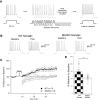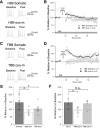Muscarinic Modulation of SK2-Type K+ Channels Promotes Intrinsic Plasticity in L2/3 Pyramidal Neurons of the Mouse Primary Somatosensory Cortex
- PMID: 32005752
- PMCID: PMC7294454
- DOI: 10.1523/ENEURO.0453-19.2020
Muscarinic Modulation of SK2-Type K+ Channels Promotes Intrinsic Plasticity in L2/3 Pyramidal Neurons of the Mouse Primary Somatosensory Cortex
Abstract
Muscarinic acetylcholine receptors (mAChRs) inhibit small-conductance calcium-activated K+ channels (SK channels) and enhance synaptic weight via this mechanism. SK channels are also involved in activity-dependent plasticity of membrane excitability ("intrinsic plasticity"). Here, we investigate whether mAChR activation can drive SK channel-dependent intrinsic plasticity in L2/3 cortical pyramidal neurons. Using whole-cell patch-clamp recordings from these neurons in slices prepared from mouse primary somatosensory cortex (S1), we find that brief bath application of the mAChR agonist oxotremorine-m (oxo-m) causes long-term enhancement of excitability in wild-type mice that is not observed in mice deficient of SK channels of the SK2 isoform. Similarly, repeated injection of depolarizing current pulses into the soma triggers intrinsic plasticity that is absent from SK2 null mice. Intrinsic plasticity lowers spike frequency adaptation and attenuation of spike firing upon prolonged activation, consistent with SK channel modulation. Depolarization-induced plasticity is prevented by bath application of the protein kinase A (PKA) inhibitor H89, and the casein kinase 2 (CK2) inhibitor TBB, respectively. These findings point toward a recruitment of two known signaling pathways in SK2 regulation: SK channel trafficking (PKA) and reduction of the calcium sensitivity (CK2). Using mice with an inactivation of CaMKII (T305D mice), we show that intrinsic plasticity does not require CaMKII. Finally, we demonstrate that repeated injection of depolarizing pulses in the presence of oxo-m causes intrinsic plasticity that surpasses the plasticity amplitude reached by either manipulation alone. Our findings show that muscarinic activation enhances membrane excitability in L2/3 pyramidal neurons via a downregulation of SK2 channels.
Keywords: engram; ensemble; excitability; learning; neocortex; pyramidal cell.
Copyright © 2020 Gill and Hansel.
Figures





Similar articles
-
SKCa channels mediate the medium but not the slow calcium-activated afterhyperpolarization in cortical neurons.J Neurosci. 2004 Apr 7;24(14):3537-42. doi: 10.1523/JNEUROSCI.0380-04.2004. J Neurosci. 2004. PMID: 15071101 Free PMC article.
-
Activity-Dependent Plasticity of Spike Pauses in Cerebellar Purkinje Cells.Cell Rep. 2016 Mar 22;14(11):2546-53. doi: 10.1016/j.celrep.2016.02.054. Epub 2016 Mar 10. Cell Rep. 2016. PMID: 26972012 Free PMC article.
-
Small-conductance Ca2+-activated K+ channel type 2 (SK2) modulates hippocampal learning, memory, and synaptic plasticity.J Neurosci. 2006 Feb 8;26(6):1844-53. doi: 10.1523/JNEUROSCI.4106-05.2006. J Neurosci. 2006. PMID: 16467533 Free PMC article.
-
Small conductance Ca2+-activated K+ channels as targets of CNS drug development.Curr Drug Targets CNS Neurol Disord. 2004 Jun;3(3):161-7. doi: 10.2174/1568007043337472. Curr Drug Targets CNS Neurol Disord. 2004. PMID: 15180477 Review.
-
SK2 channel expression and function in cerebellar Purkinje cells.J Physiol. 2011 Jul 15;589(Pt 14):3433-40. doi: 10.1113/jphysiol.2011.205823. Epub 2011 Apr 26. J Physiol. 2011. PMID: 21521760 Free PMC article. Review.
Cited by
-
Blockade of the M1 muscarinic acetylcholine receptors impairs eyeblink serial feature-positive discrimination learning in mice.PLoS One. 2020 Aug 13;15(8):e0237451. doi: 10.1371/journal.pone.0237451. eCollection 2020. PLoS One. 2020. PMID: 32790748 Free PMC article.
-
Intrinsic threshold plasticity: cholinergic activation and role in the neuronal recognition of incomplete input patterns.J Physiol. 2023 Aug;601(15):3221-3239. doi: 10.1113/JP283473. Epub 2022 Aug 11. J Physiol. 2023. PMID: 35879872 Free PMC article.
-
Taurine depletion during fetal and postnatal development blunts firing responses of neocortical layer II/III pyramidal neurons.Front Mol Neurosci. 2022 Nov 17;15:806798. doi: 10.3389/fnmol.2022.806798. eCollection 2022. Front Mol Neurosci. 2022. PMID: 36466806 Free PMC article.
-
Cortical acetylcholine dynamics are predicted by cholinergic axon activity and behavior state.bioRxiv [Preprint]. 2024 Feb 1:2023.11.14.567116. doi: 10.1101/2023.11.14.567116. bioRxiv. 2024. Update in: Cell Rep. 2024 Oct 22;43(10):114808. doi: 10.1016/j.celrep.2024.114808. PMID: 38352527 Free PMC article. Updated. Preprint.
-
Intrinsic plasticity and birdsong learning.Neurobiol Learn Mem. 2021 Apr;180:107407. doi: 10.1016/j.nlm.2021.107407. Epub 2021 Feb 22. Neurobiol Learn Mem. 2021. PMID: 33631346 Free PMC article. Review.
References
-
- Belmeguenai A, Hosy E, Bengtsson F, Pedroarena CM, Piochon C, Teuling E, He Q, Ohtsuki G, De Jeu MT, Elgersma Y, De Zeeuw CI, Jörntell H, Hansel C (2010) Intrinsic plasticity complements long-term potentiation in parallel fiber input gain control in cerebellar Purkinje cells. J Neurosci 30:13630–13643. 10.1523/JNEUROSCI.3226-10.2010 - DOI - PMC - PubMed
Publication types
MeSH terms
Substances
Grants and funding
LinkOut - more resources
Full Text Sources
Molecular Biology Databases
